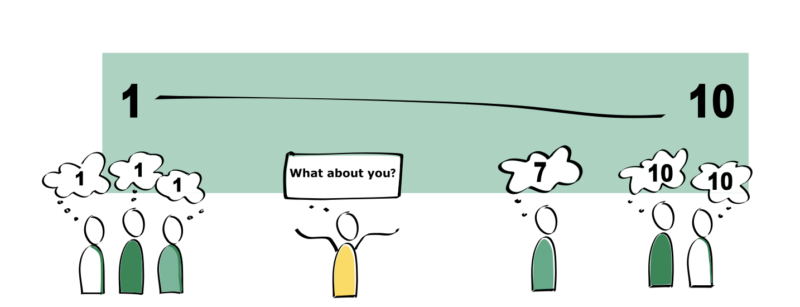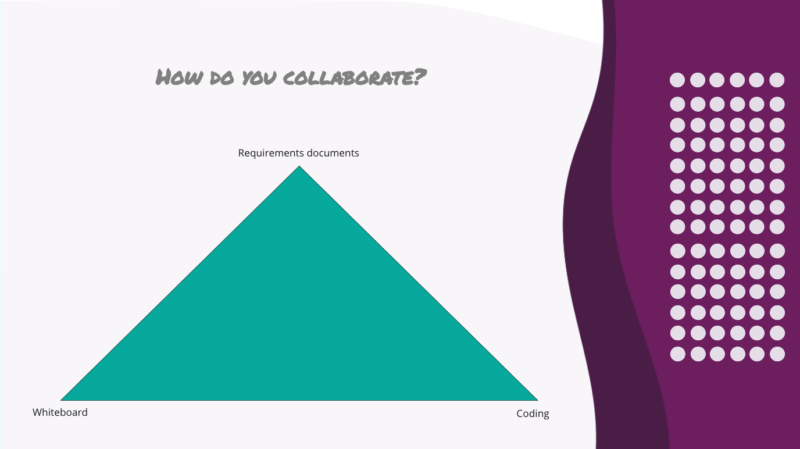Discovering and interpreting beliefs in groups
Ever been part of a conversation that seemed to revolve around the same issue over and over again? Or a meeting where some people keep diving into details and others want to stay more high-level? As consultants, we often come across these kinds of sessions. We noticed that these situations can lead to tension, slowing down and (healthy) conflict. Over time, we learned how to tackle these situations by using sensemaking, a technique that offers us the right insights to guide a workshop or decision-making.


What do we mean with sensemaking?
Sensemaking is what the word says, making sense of the environment. Its purpose is to get an understanding of the group and elements in play. These could be perspectives, opinions, preferences, stakes and/or beliefs. We search for the things that are not said. Gut feelings, worries or other forms of concerns. Making these concerns explicit and visible provides valuable information, helping the group make the right decisions or get to effective action. For us, as facilitators, it means making sense of the thoughts, opinions and emotions of the group. Let’s clarify with an example.
At a client, we facilitated a large group session. The goal of the session was to discover the influencers of the software delivery process. Over time we, as facilitators, felt that the discussion came down to the same unspoken issue. We decided to test our hypothesis by posing a sensemaking question, and asked the group: “Do we build a product or custom-made solutions?”.
This question made the existing polarity very explicit. Polarities come in different forms, but we tend to test for dualism. Testing the black and white, you could say. In our example, the question displayed the two beliefs that were present in the company—highly important, but rarely spoken about. It formed the basis of many discussions and issues in the software delivery process. Making these underlying beliefs visible brought relief to the group, leading to actionable items to manage the polarity.
What insights can you discover with sensemaking?
The beauty of sensemaking is that it is a relatively easy thing to do, although it does take some time to design the right questions. Sensemaking is highly context dependent, meaning, you will have to establish a clear understanding of the group and its needs before you can ask the valuable questions. A key factor is in creating the safety to encourage honest answers from the group. It requires effort to listen with care as a facilitator, emphasising your role to guide the conversation. The benefit is that the insights are quite valuable. It transforms the discussion (I’m right, you’re wrong) into the conversation (let’s try to see and understand all perspectives), rather than offline dialogues and fuzz afterwards.
During check-ins, sensemaking questions can be a great way to discover and level the group. We love to use these kinds of questions to understand the polarities in the group, for example, “do you prefer to code in a group or individually?”. But, also a simple question as “how is your energy today?” helps to make sense of the group that is taking part in the session.

Sensemaking can be helpful to gain a full picture before making decisions. It’s not about generating a pros and cons list, it is to learn about viewpoints, perspectives and opinions on the decision about to be made. For example, a confidence vote on the proposed decision can be a great way to get insight.
We are on the same page, right?
A great feature of sensemaking is making individual contributions visible. Everyone needs to communicate where they stand regarding the question. You might think the group is on the same page, but sensemaking shows you whether the group really is. For example, you might want to see if people agree with the solution to a problem. Simply put, the group on a scale of 1 to 10 if people feel confident this is the best solution for the problem. Everyone around the same number? Great. Are there outliers? Also, great! Invite the outliers to bring their perspectives forward and have a dialogue.
Online, offline, hybrid?
Given the current global situation, our meetings take place online, offline or are hybrid. Sensemaking remains a truly valuable technique in all these forms. There are different ways of getting the most valuable insights based on how your meeting takes place.
In our online meetings, Miro is our best friend. Creating frames like the one above is easy, and people can add their perspectives in different ways—even anonymously when this is desirable. We found sensemaking especially helpful in online meetings. Online meetings lack the ability to observe and experience non-verbal communication. Posing sensemaking questions replaces this, as it makes emotions and opinions explicit.
In our offline meetings, we can get more creative. We still use similar frames, but we draw them and let people walk up to a sheet of paper and ask them to place a dot. The movement itself also tells you a lot about the dynamics in a group of people, so pay attention ?. We like our groups to be active, that’s why we also use the ‘physical sensemaking approach’. We ask a question, and then ask people to form a line based on their beliefs. An example: during our first offline meetings in COVID times, lots of people were still a bit uncomfortable. We asked the question: “How comfortable are you with being in the same room?”. The line ranged from 1-10 and across the whole room (yes, 1,5 meter distance was possible). Some people were pretty uncomfortable, which allowed us to ask what they needed for this session to work. The entire group made working agreements about this, and we could continue with a very productive session.
You are invited to try it out
When facilitating your next session or meeting, we invite you to try sensemaking, to better understand your participants or to see whether you have actually reached consensus on a decision. How are you going to make sense of what is going on? We wish you all the best and fun experimenting!

Recent Comments